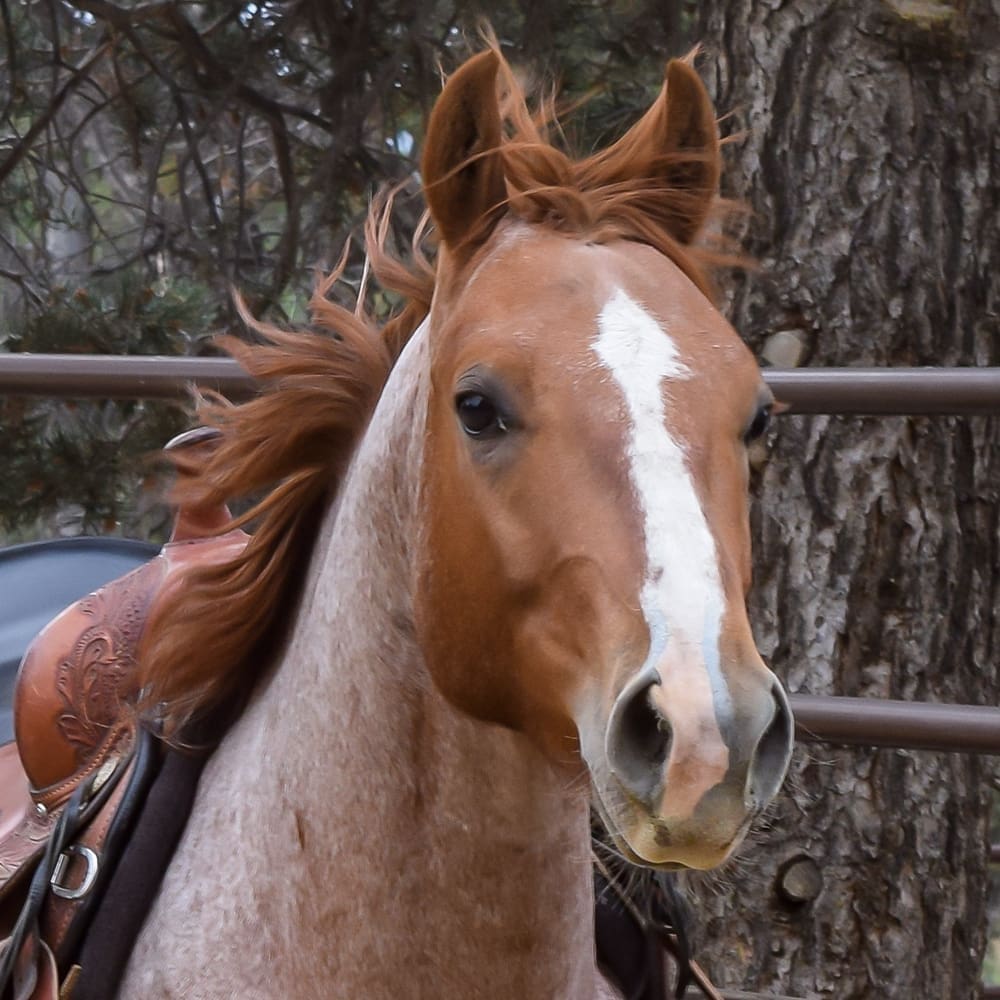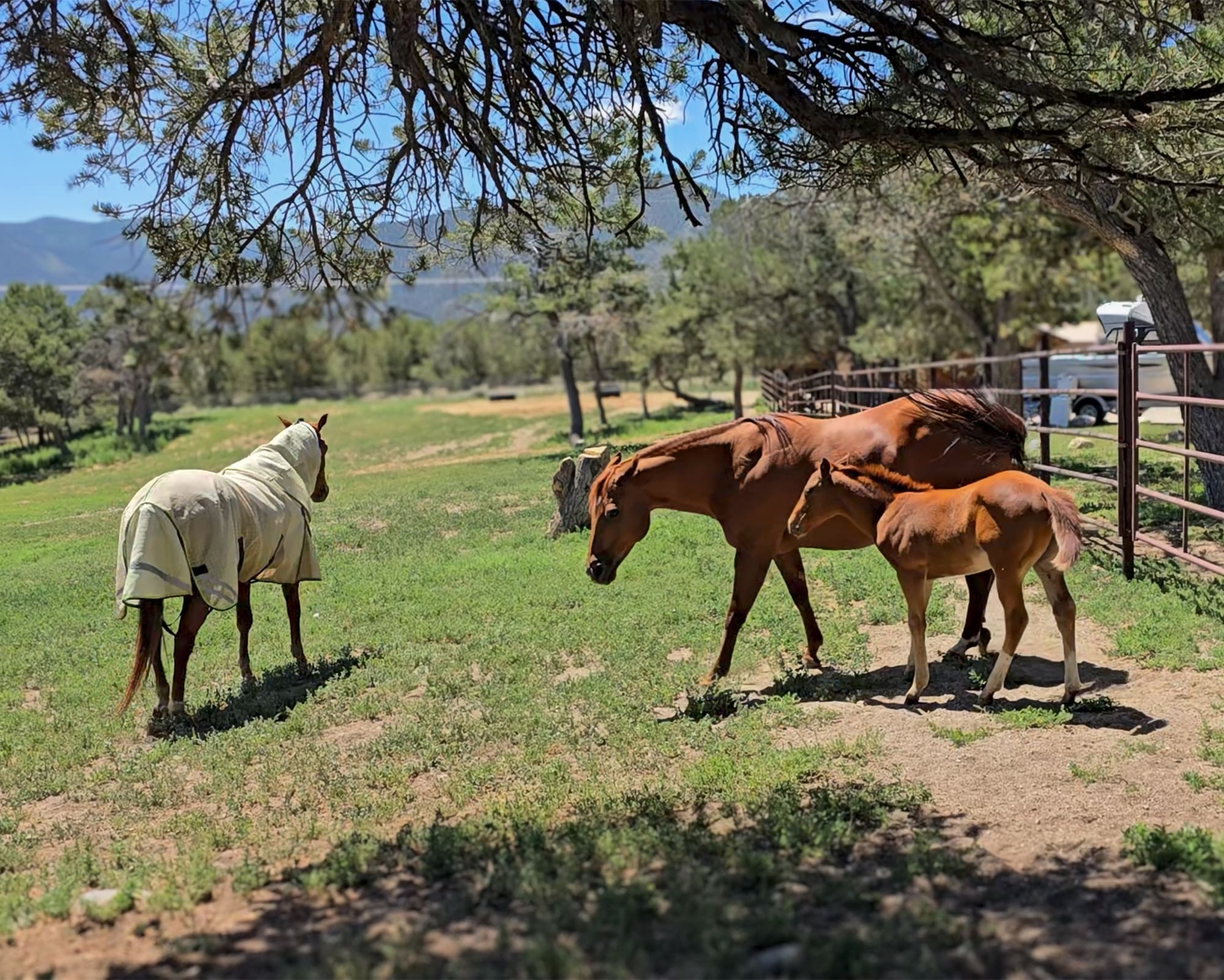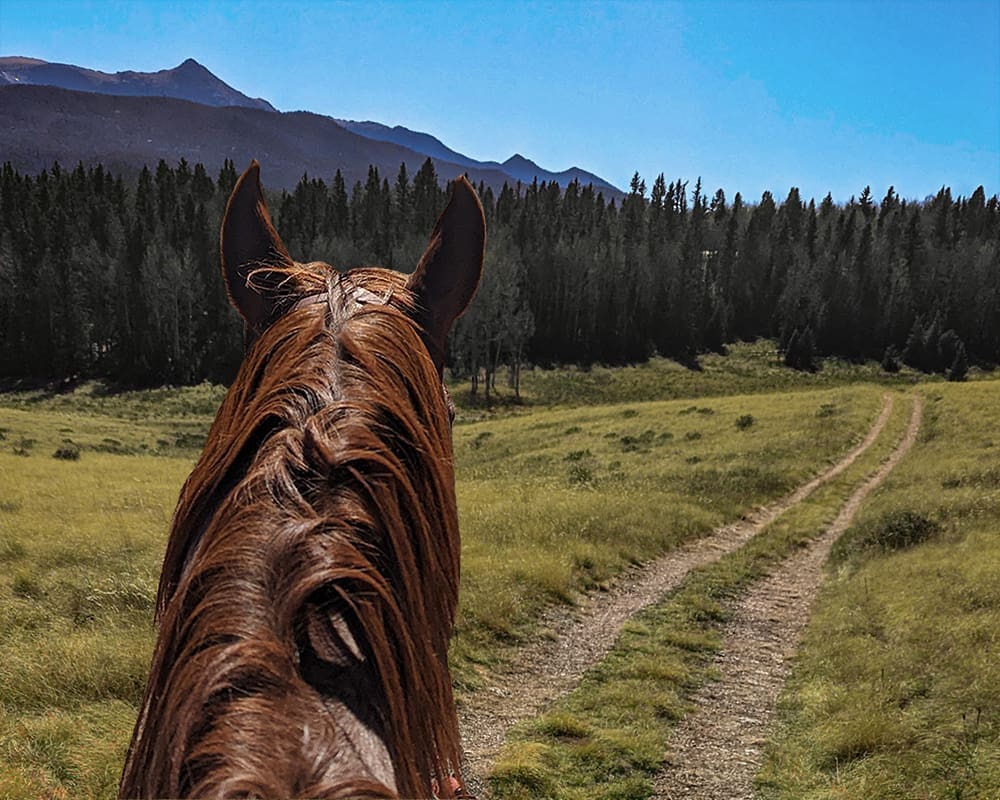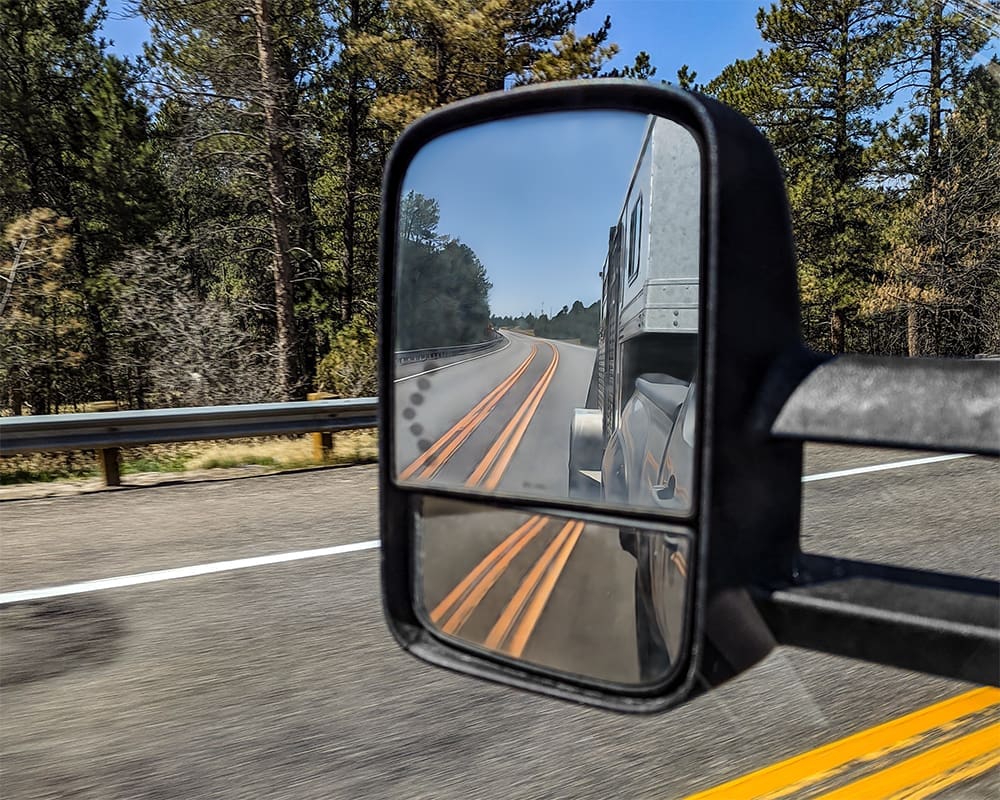
Like my fruits and vegetables, I prefer my horses fresh. It’s clearly not for everyone, but I enjoy riding a horse that’s a little bit excited, that’s looking down the road, eager to get there and curious about what job awaits him. It took me about forty years to realize it, but I prefer a horse with a big motor and a busy mind. To me, it’s more fun than riding a horse that’s sluggish, insensitive and looking for a way out of work. But a fresh horse is neither fun nor confidence inspiring to many riders.
What is a fresh horse?
A fresh horse is one that has not been handled or ridden for an extended time or for a longer period than normal. Perhaps it’s a horse that’s simply not in a regular riding routine or hasn’t been ridden in a few days. At one end of the extreme, it could be a horse that’s been turned out with the herd for several years without any riding or handling, and at the other end, maybe it’s Monday and that horse just had the weekend off.
Because horses are emotional animals, a horse might be in a fresh state of mind because of the situation it’s in. Riding in a strange area or with unknown horses can sometimes cause emotional overload. When something changes in a horse’s known environment, like a new banner on the fence, it can temporarily blow his mind. Maybe the wind is howling, putting a normally calm horse on edge. Often a nervous or excited horse feels just like a fresh horse— it’s more horse than you are used to.
What does fresh look and feel like?
A horse with the freshies tends to be high-headed, energetic and easily distracted. It may be looking around a lot, calling out to other horses, fidgeting. It’s muscles feel and look tight (we call that “on the muscle”) and sometimes the rider feels a hump in the horse’s back that may morph into a little crow-hop. It’s often the result of pent up energy in the horse, not the result of disobedience or defiance. There’s a big difference.
If a trained horse has simply had a time off, even if it’s been months or years, it does not forget its training or become untrained, let alone become disobedient or defiant. Horses retain their training forever; they don’t unlearn, although they may benefit from occasional reminders.
However that horse was left before the lay-off, is the same horse that you get back, once you get the freshies out. While I expect a fresh horse to be energetic and need some re-tuning, that should not translate to disobedience if the horse was properly trained to begin with. Defiance and disobedience are signs of poor training, not a fresh horse.
Whether your horse has been laid off for days or weeks or has had time off due to weather conditions, vacation, physical rehab or some external reason, there are a few steps you can take to make sure your first few rides on a fresh horse go well. From take-off to landing, it helps to pay attention to details, to insure a smooth and safe flight.
Pre-Flight Checklist
At its best, riding is a physically demanding and somewhat risky activity. When a horse is fresh, it’s important to be thorough in your preparations and make sure all conditions are perfect for flight. If we always consider the worst-case-scenario with horses, it will keep us safer. Minimally, I want to make certain that my tack is right, the environment is conducive to training, and my horse is in the right state-of-mind. Before I take that first ride, I’ll go through a pre-flight checklist, to make sure all conditions are right.
- Saddle fit and tack check: If the horse has had weeks or months off, it pays to reassess saddle fit. A horse’s body shape changes rapidly with age and conditioning, so saddle fit is a constant concern. With an extended layoff, it’s even more important. Pads may need to be adjusted; billets and latigos may need adjusting. Check all parts of your tack, especially if it hasn’t been used in a while. Adjust the headstall/bit/curb strap; look for wear spots where metal meets leather; check Chicago screws and other connections.
- Safe footing: Keep in mind that the fresh horse is probably going to outrun his lungs. Like most horse trainers, I’m a fanatic about soft, freshly-groomed and consistent footing. A fresh horse may be physically out of shape or coming off injured reserve and in his excitement, he may run fast and buck hard in the groundwork and trot/canter hard when I ride. I want deep enough footing that my horse has plenty of soft ground underneath him, but not so deep that he over-stresses his tendons. I don’t mind mud unless it’s slippery, as long as the footing is consistent.
- Groundwork for focus, not to tire: If the fresh horse is nervous and a looky-lou right when I pull him out of the stall, some groundwork is indicated. If the well-trained horse is mannerly from the start, listening to me, standing quietly while tied and compliant, I may skip it. If I do groundwork with the fresh horse, my goal is to get the horse to listen to me, follow instructions and demonstrate compliance. It is not to “get the bucks out” or tire out the horse. In my experience, people who say that are often inadvertently training the horse to buck on the lunge line.
- Ground School. For groundwork, I use a premium rope halter, with a 15-foot training lead; I may also employ a flag or boundary stick. I start with leading the horse around at walk and trot, doing turns and stops, to check its manners, its awareness of boundaries and its focus on me. Then I might circle the horse on the end of the line and ask it to turn around and trot off a few times. If it gives me green lights, I may only spend a couple minutes in groundwork before I step up in the stirrup. If I think the horse really needs to blow off some steam, due to excessive confinement or extreme emotionality, I’d rather use the round pen or turn him loose in a bigger pen (assuming re-injury is not a concern).
Cleared for Take-off
Once I swing a leg over the back of a fresh horse, we are wheels up. As soon as I settle in the saddle, I will ask the horse to move forward at either walk or trot. If he’s truly fresh and has a lot of energy, I want to send that energy in a positive direction. Riding and training horses is entirely about controlling forward movement—start with the forward, then gradually start guiding the horse more and more.
- Forward motion is the basis of all training. Working trot is the best gait for a fresh horse. It covers the most ground and is the most efficient gait for the horse. If he’s really fresh, I’ll jump right to working trot as soon as I get on and keep him at that gait for at least ten minutes. That’s enough to take the air out of most horses. After that, we can usually settle into some more serious work.
- Lower your expectations for performance, but not for obedience. I don’t expect a horse that hasn’t been ridden in months to be as sharp in his skills as he was in the peak of his training, but I always expect and require obedience. If he hasn’t had a reason to think about riding cues in a long time, he’s a little rusty and I will give him the time he needs to regain his performance skills. But I expect him to go in the direction I choose, at the speed I dictate, without argument. Having time off does not change the rules of expected behavior.
- Bending, not pulling, to control speed. A hot blooded, forward moving horse that has been laid-off or cooped up, is going to have a full tank of gas and be eager to go. What never works well on a horse like this is to try to control speed by pulling back on two reins. Instead, I prefer to control speed or excessive energy by bending the neck of the horse softly from right to left to right to left. When the horse builds speed, I gradually bring him onto an arcing circle, increasing the bend in the neck until I feel him gear down a notch, then letting him go straight in reward. Remember, the goal is to control forward motion, not stop it. A lot of behavioral problems stem from the latter.
- Changes of direction matter. If I am bending the horse to control speed, I will also throw in some changes of direction too. I never go ‘round and ‘round in one direction; instead, I change directions often. This has the double-effect of bending the horse and showing the horse I control its direction. Changes of direction are a powerful tool on a horse that’s excited, scared or feisty.
- Be prepared for spooks. A nervous or excited horse is more prone to spook, spin and bolt. Mange your rein length and know how to shorten and lengthen your reins blindfolded (my rope reins are the perfect length and are easy to manage); know how to execute the emergency stop (see my YouTube video on Pulley Rein). Don’t ride the horse as if he is going to spook (because he will), but be prepared to react if he does.
- Rest in the far corners. After extensive trotting, circling, changes of direction, hand gallop and canter, when the horse reaches his full aerobic capacity (maxVO2), I will take him to one of the far corners of the arena (where he doesn’t want to be) for rest and recovery. This addresses barn sour tendencies and teaches the horse to enjoy the part of the arena he normally avoids.
Horse, this is Your Captain Speaking
Besides getting the fresh off the horse and dissipating his pent-up energy, my main goal with this horse is to remind him of how we do business, who is in charge and who will be making all the decisions (me). I’m less concerned on the horse’s accurate response to specific cues, and more interested in re-establishing a productive working relationship. With that in mind, there are some specific parameters that I work within.
- No looking around. Focus on the job ahead of you. This is a strict rule of mine on any horse, but especially for the green or fresh horse. A horse that is looking around excessively is not focused on me or the task ahead. I simply disallow it by bumping the outside rein once when the horse turns its head to look. As soon as the nose crosses the line of its shoulder, I issue the correction. Using good timing and the right amount of pressure, the horse stops looking for his escape and brings more focus to riding within a minute or two.
- Breaking gait (up or down) is bad. Whether the horse is lazy or full of gas, he doesn’t get to pick the speed. Ever. You don’t want a thousand-pound flight animal thinking he controls the speed. A fresh horse needs to move forward, so I proactively take charge by asking it to move forward before it has the chance and for longer than it wants to. Holding that forward horse back when it’s fresh is a bad idea; it’s better for me to be the one asking for speed (and the horse asking to slow down).
- Control direction; don’t compromise the path. Just as with speed, I also don’t want my horse thinking it gets a vote in where it goes. If the horse is avoiding the far corners, pulling toward the gait or otherwise veering off the path I have chosen, I will address it. If the horse is nervous or full of itself, I may not take it immediately to the scary places, but it’s important that I maintain control of the direction. I may employ changes of direction, but always turning the horse away from where he wants to go (the gate) or toward the place his is avoiding (the scary place). This kills two birds with one stone: the changes of direction give me more authority over the horse and turning toward scary or away from home will make sure the horse does not benefit from its disobedient actions. If I let the horse veer-away from a place I’ve directed it to go or let the horse pull me in a direction without addressing it, it is learning the wrong thing.
Us horse trainers like to talk about riding the horse underneath you and staying in the moment. Ride the horse that showed up today; play the hand you are dealt. They are not robots and they all have good days and bad days. It’s the rider’s job to adjust to the needs of the horse, in the moment and ride proactively.
Just because a horse has pent-up energy or hasn’t been ridden for an extended period, does not mean he is a bad horse or that he has become untrained. Think about kids going back to school after summer break. They are a little wild and may need a few days to fall back into the routine, but they know how to do it. Contain and direct their energy, remind them of their manners, and get their mind back in the game. That’s what you want to do with the fresh horse.
As always, with horses, keep your safety and the safety of your horse, first and foremost in your mind. And don’t forget… enjoy the ride!



